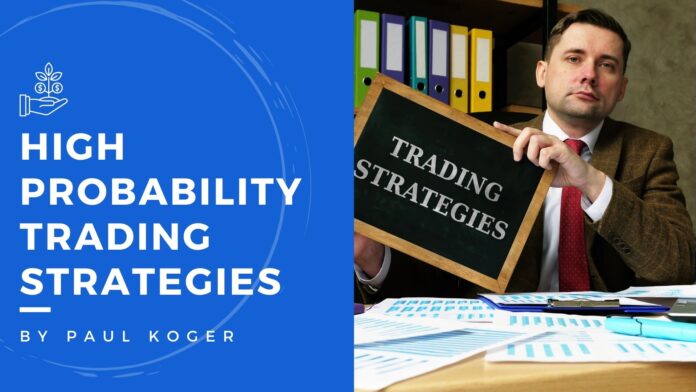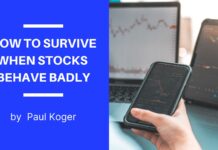Table of Contents
It requires two related skills to be consistently profitable in trading:
One is the ability to recognize and use trading strategies that make more money than what you lose and another is to make sure that such strategies respond to the changing market conditions.
In short, the trading strategies you choose to adopt must perform well, even when the market experiences bull and bear impulses. And when I say trading strategies, what I meant is high probability trading strategies.
But what is it really? Well, that’s my main purpose for this guide. This reliable resource details the trading strategies with beginners and serious traders in mind.
Before the end of this post, you will learn:
- What high probability trading is
- What are some of these strategies and trading opportunities, which are intended for both short- and long-term traders, and
- How you can make these high probability trading strategies work for you
So, without further ado, let’s begin with…
What Is A High Probability Trade?
High probability trading refers to the likelihood that a trade will win or when odds of the market are in your favor, whether that be in the stock markets, ETF, forex, or the options market.
Making high probability trades is an important thing to consider to become a successful trader. This is because no matter how great a trader you are or will be, you may have losing trades. Losses can happen because the market moves in unexpected ways.
So, to create an edge over the market, you use a high probability trading strategy. It’s not a simple rule but it will help stack odds in your favor in every trade you play.
And some high probability trading strategies that I can suggest include the following:
Practical High Probability Trading Strategies – Entry to Exit
Trading Strategy #1: Identify Profitable Trade Setups (The Entry Strategy)
A trade setup is a condition that needs to be present before you consider a trade. More like your reason for trading. For instance, if you are a trend trader, then a trend has to be present.
Some traders use confirming conditions, like an indicator or a pattern.
And if your reason for trading – the trade setup- is present, you further need an exact event that will tell you now is the ideal time to trade.
I caution you, though, that identifying high probability trading setups is one of the most challenging tasks in trading. Most often, it is even a process of trial and error.
Even for me. I remember when I was starting my trading journey, I did not find it easy to generate consistent profit in trading. Thankfully, I later learned after developing my own strategies and applying proper trade management.
Key points to identifying profitable trade setups
- Be familiar with reading market charts and patterns
- Use a good stock screener
- Stick to your indicators
Trading Strategy #2: Analyzing Market Behavior
After identifying profitable trade setups, the next in my list of high probability trading strategies is to analyze market behavior. Yes, it’s no secret that the power of the masses drives the market.
Also, fundamental parts of analyzing market behavior are its give-and-take and its up-and-down fluctuations. But these should be a part of your practical trading plan.
My take on this is that when the markets are going nowhere, don’t just abandon a good trading strategy. Be patient and wait when the opportunity presents itself and when it does, enter the market and trade confidently!
Trading Strategy #3: Trade with the Trend

The trend can give you the biggest bang for your buck. It could mean an uptrend or downtrend. The uptrend comprises higher highs and lows while the downtrend comprises lower highs and lows.
My recommended step to a serious trader, if they want to go along with the market, is that they determine how long they want to stay in the trend.
If you want to trade intraday (for several hours only), then know the trend on the daily timeframe.
Next is you identify the trend (whether in the forex, futures, and stock markets). You can also check analytics and economic news to understand which news or economic factors stand behind such a trend.
Some sophisticated traders draw trend lines, making these a signal for them to buy. Lastly, put a protective stop loss on the trend line.
Trading Strategy #4: Use Stochastic Indicator
Using Stochastic to know areas of value should be a part of your practical trading plan too. Not many traders use this momentum indicator, but it’s good in managing trades from entry.
Basically, it’s a two-line indicator that you can apply to any chart. It shows you how the current price compares to the lowest and highest price levels over a predetermined past period. The Stochastic indicator may fluctuate between 0 and 100.
Still confused? Then, let’s visualize a rocket flight. The rocket goes upward in the air and when it runs out of fuel, it slows down before it can eventually turn down.
In other words, the Stochastic measures the momentum of price. And as George Lane, the creator of the momentum oscillator, said “momentum always changes direction before price.”
Trading Strategy #5: Set a Price Target on Your Stocks
This post on high probability trading strategies won’t be complete without this part. It’s setting a price target on your stocks the same day you purchase them.
It should be based on the stock’s P/E (price-earnings ratio) and then multiplied by the expected future earnings. Ask yourself: What price can the stock achieve within 18 to 24 months?
The goal should be at least a 30% to 50% gain. If it does not have that potential, I encourage you to keep looking at other stocks in the stock market.
Trading Strategy#6: Use Reward-to-Risk Ratio
Don’t take trades unless they have positive risk-reward ratios. Even when there appears to be a good trade opportunity, such as a major market reversal, simply let that opportunity go by and wait for where you can get a low-risk entry.
Trading Strategy#7: Plan Your Exit
Another important part to include in your high probability trading strategies is to plan your exit. Remember that there are two ways you can exit a trade: taking a profit or a loss.
Without including an exit strategy in your practical trading plan, you are more likely to make trading decisions that will be based on emotions, like greed and fear.
You can use a stop-loss order so that it enables you to automatically exit a trade at a certain level when the current market price is less favorable to you.
Be mindful also of these magic time frames when to take your hard-earned money out of the financial markets:
- Minutes to hours for day trading
- Hours to days for swing trading
- Days to weeks for position trading, and
- Weeks to months for investment timing
Let’s Sum Things Up

All the shown entry to exit strategies, especially identifying profitable trade setups, analyzing market behavior, and managing trades from entry, have high probability and offer a comprehensive approach to trading.
If your trade meets these high probability trading strategies or entry to exit tactics, then I believe it’s already a good trade.
And once you fully understand these trading strategies and develop your own strategy, I encourage you to put your trading skills to test using free stock markets simulators.
That way, you can first trade confidently in a virtual environment before you risk your own hard-earned money. And when you enter the real deal (your options are: forex, futures markets, and stock markets), you already have enough practice and it will be easier to look at metrics, like the profit target and trading setups.









![Etoro Review – My Honest Opinion [+TUTORIALS]](https://foxytrades.com/wp-content/uploads/2018/03/Etoro-Review-100x70.jpg)
